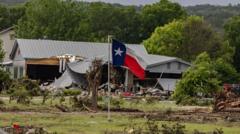Recent flash floods in Texas have reignited discussions about the inadequacies of early warning systems, with analysts stressing that improvements are essential to mitigate loss of life. Comparisons are made to past disasters in locations like Valencia, Spain, where ineffective alerts led to tragic outcomes.
Global Challenges in Flash Flood Prevention Highlighted by Recent Disasters

Global Challenges in Flash Flood Prevention Highlighted by Recent Disasters
Experts suggest critical gaps in early warning systems as flash floods cause devastation in various regions.
Officials in Texas are facing intense criticism for their reluctance to allocate funding towards effective early warning systems for flash floods, despite the region's history of sudden, intense rainfalls. In a recent disaster along the Guadalupe River, at least 121 lives were lost, including the tragic death of 36 children. Experts advocating for enhanced disaster preparedness emphasize that even with advancements in forecasting, merely predicting a flash flood is insufficient to avert disaster outcomes.
According to Erin Coughlan de Perez, a disaster risk management researcher from Tufts University, flash floods present significant difficulties for disaster prevention. Countries of all economic standings grapple with the challenges of funding systems capable of accurately forecasting extreme rainfall, which often either fail or trigger numerous false alarms that diminish public trust.
The situation echoed in Valencia, Spain, where last year’s devastating flash floods resulted in over 200 fatalities due to insufficient warning measures. Although an alert system was in existence, it was not activated promptly enough, leaving individuals unaware of the impending crisis until it was too late. One resident poignantly recalled the loss of their grandfather to the floodwaters after the alerts were finally issued.
Dr. Coughlan de Perez highlighted that the ‘cry wolf’ issue is exacerbated by the unpredictable nature of flash floods and noted their increasing frequency and intensity due to climate change. Such disasters, often overlooked, require significant investments in adaptive and reliable warning systems, which remain underfunded in many parts of the world.




















